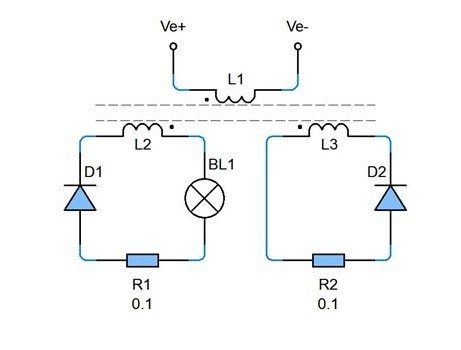Free Energy Transformers

Transformer
ET Transformer
(2024-10-11) Updated
Overunity in transformer flyback mode
Anomalous power efficiency of a transformer driven by tuned duty cycle pulses by
O. Ide, L. Danczykb - 2012
Replication of the Ide transformer device by Horst Eckardt, Bernhard Foltz -
December 2, 2016
Detailed measurements of Ide transformer devices by Horst Eckardt, Bernhard Foltz,
Karlheinz Mayer - July 16, 2017
Pulse transformer operating principles
Xiaodong Liu, Qichang Liang, Yu Liang - A Novel Transformer with Compensating Coil
 MTECH INDUSTRIES RESEARCH CO LLC
MTECH INDUSTRIES RESEARCH CO LLC
Paul Raymond Jensen - The Unidirectional Transformer (UDT)
BiTT - Bi-Toroid Transformer by Thane C. Heins and MrDKONZEN
 Transformers and coils
Transformers and coils
Bi-toroid Transformer replication (over unity transformer)
- André Coutier Transformer Video
Y. B. F. J. Groeneveld - Amplifying Transformer: US 1,702,771
Gennady Markov - Bi-Directional Current Transformer: CA 2,224,708
 No CEMF Transformer
No CEMF Transformer
Johnson, Bud T. J. - Electrical Generator - Solid State Configuration CA 2,357,550
Iyad Baghdane, Alexis Herrera - High efficiency power generation system and a method
of operating same USP 10,770,937
Hi Simon,
Take a look at link: No CEMF Transformer and
read the pages and try to follow his way of thinking. Is the output of the secondary
Volts-Amperes-Reactive? and because it is a transformer it has a phaseshift between
Volts and Ampere on the input also? Is it the reason for almost no input power from
the wall?
Best Wishes, Hermes
http://gratisenergi.se/fetrans.htm
https://www.mooker.com/thread-126.html
Hi Hermes,
Seems they
think counter-EMF is actually a thing. It's actually just a result of the magnetic
flux in the coil changing, and if you change the flux through a coil you're going to
get an induced voltage. Also happens anywhere there's a possible electrical circuit
and a changing magnetic flux through that circuit, which is why there's eddy-current
and eddy-current losses and heating.
If you wind a coil around the total width
of a core, rather than on each leg, it doesn't give you no magnetic circuit, just
means that part of the magnetic circuit is in the air instead of in the ferrite. The
secondary coil around one leg will pick up the changes in magnetic flux through it
from the primary, but the large air-gap means that the flux-change is reduced from
what it would be, if it was all ferrite along the magnetic path.
Putting a
signal on the secondary, the net flux through the primary will be somewhere near zero
(some leakage outside the ferrite). Thus seems like this configuration will give you
transfer of AC from primary to secondary, but not the other way. Seems you should be
able to improve the coupling by adding a complete (non air-gapped) ferrite path for
the primary. Looks like it might end up non-symmetrical, and if so there's a chance of
something odd happening. However, I expect that careful measurements will show that it
remains symmetrical as regards energy passed across in each direction.
Coils
store energy in the magnetic field they produce, so there's a time-delay built-in as
you put electrical energy in and it goes into the magnetic field. Time delay, when
you're using AC, is seen as a phase-change, and the phase-change you see depends on
the frequency you're using as well as the voltage and current applied to the coil.
Other coils see a change in the flux through them and produce a voltage (that's your
CEMF or back-EMF) and if they are allowed to produce a current from that then the
energy from the field gets used to produce that power from the coil.
Thus you
need to see the system as a set of coils or conductive paths with a common magnetic
flux that they see, though each conductive path may see a different proportion of the
flux. Put energy in in one place, and it goes into the magnetic flux and can be taken
out at any circuit that interacts with that flux. The act of allowing current to flow
in a circuit from the change of flux however takes energy out of that change, and as
far as we've seen so far it's precisely symmetrical as regards the energy you can get
out and the the magnetic energy stored. While that underlying symmetry holds, so does
the energy conservation law.
So see
http://gratisenergi.se/prjensen.htm
and
http://gratisenergi.se/compcoil.pdf
and you'll see that this sort of thing has been tried before. Openly published, and if
it worked then we'd be using it because someone else would have tried it and found
that it worked. Might seem a bit of a bummer that this doesn't work, but that's the
reality. It doesn't work, and unless you figure a way to break the underlying symmetry
then it will continue to not work. If a coil (or other electrical circuit) passes
current, then that will change the magnetic field it produces, and likewise if the
magnetic field it sees changes then it will get an induced voltage and current. The
magnetic field acts as a bank for the energy for all circuits that see that magnetic
field. To get energy out in one place, you need to have put it in in another place. No
overdraughts possible.
Best regards, Simon
back to linkpage
suggestion
read and sign my guestbook
